Table of Contents
Individuals with osteoporosis and a history of vertebral compression fractures need to do exercises that strengthen the spine and back. Exercises for the spine and back are especially important if you have had a vertebral compression fracture because the risk of further compression fractures increases dramatically after the first fracture. This post covers a series of exercises for people with osteoporosis who want to safely strengthen their spine and back. I present the exercises in order of intensity so that you can progress gradually and safely challenge your back and spine over time.
Back Exercises for Osteoporosis of the Spine
A strong back reduces your risk of further vertebral compression fractures. It also allows you to stand straight for long periods of time and perform day to day activities with better body mechanics. These last two benefits further reduce your risk of additional vertebral compression fractures.
An individual patient can have a good bone mineral density score at their hips, but have low scores at their spine. When I look at that person’s exercise history, I often see that they do a lot of hiking, walking, or running. Unfortunately, I often find that they do little upper body (and specifically back) strength training. Upper body strength exercises are essential to help osteoporosis in the spine.
Aerobic Exercises and Osteoporosis of the Spine
Most aerobic exercises (including hiking, walking, running and dancing) are great weight bearing exercises, but the ground reaction forces (the vibration that runs up the leg bones and stimulates the bones to stay strong) do not get past the pelvis. Thus, the spine gains little benefit from these weight bearing exercises.
In order to build bone in the spine, the muscles that are attached to the spine need to be challenged to work hard. This means that you need to do exercises that target the spine and the back.
I recommend that most people start with the Floor or Prone M.
Are These Back Exercises Normal?
Before I get into the exercises, I would like to share a thought. Many clients with osteoporosis are surprised when I prescribe these exercises. Some think that the posture alignment I want them to have is not achievable. However, I tell them that the posture is perfectly natural.
Don’t believe it? Take a look at a baby as he starts to explore the world. When he is prone, he will lift his torso up, reach out his arms and try to grab the thing that has caught his eye.
Strong back muscles are a natural part of our condition and, like an infant, we should try to reclaim that healthy posture.

Exercises for Osteoporosis of the Spine
Each of these exercises targets the spine muscles, muscles surrounding the spine (the neck extensors, back muscles, and shoulders) and the bones of the spine. The exercises for osteoporosis of the spine are:
- Prone Exercise • M Position • Active Level (also known as the Floor M)
- Ball Exercise • T, M and Y Positions • Athletic Level
- Ball Exercise • T, M and Y Positions • Elite Level
- Spinal Stretch
Let’s start with the Prone Exercise in M Position for Active Level.
Prone M Back Exercise for Osteoporosis of the Spine
The Prone M back and spine exercise is the starting point for most people because your arms are close to the torso and the load is the lowest of all the the floor exercises.
The Floor M exercise strengthens the muscles along your whole spine but normally the muscle soreness should not be there every time you do it. It is not unusual the first time or two, or if you have not done it in a few weeks and you start up again.
- Some common issues I see that can help you trouble-shoot are:
Lifting your body too high off of the floor. You will not benefit more by going higher. Just lift your head, arms and chest off an inch or so. - The pillow that is placed under the pelvis is either forgotten or too small. The larger your breast, the thicker the pillow should be. The height of the head support should match your pillow height.
- Not stretching out after/in between sets. Some spines just don’t love a lot of extension. If yours is one of them you may want to roll onto your back and hug your knees to your chest after each set.
I hope one or all of these tips allow you to continue strengthening without discomfort the next day.
Many of the exercises that target the spine do so indirectly but the real winners that target the deep spinal extensors are the Floor M, and the Ball M, T and Y’s.
Targets:
- Muscles: Neck Extensors, Spinal Extensors, Back, and Shoulders.
- Bone: Spine.
Prone Exercise in M Position for Active Level • Instructions
The following are the instructions for Prone Exercise in M Position for Active Level — the first of four exercises for osteoporosis of the spine.
You will need a pillow to support your pelvic area and a little towel to place underneath your forehead.
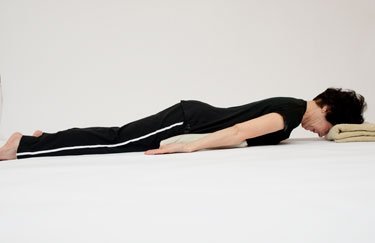
- Arms down by your side.
- Focus on lifting your torso off the floor with your head in alignment with your body the whole time.
- Come down, arms at your side.
- Take a nice breath in, and slowly, gently press the front of your pelvis into the pillow. This will help with stability.
- Squeeze your shoulder blades together, open your shoulders, and by doing so, your palms turn away from you.
- Lift your chest and your head off the floor, so your neck lifts off.
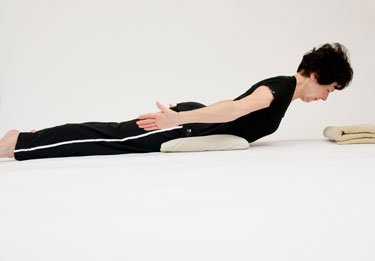
Head in Neutral Position
Keep your head in a neutral position throughout the exercise. You can do this by keeping your eyes staring directly at the towel in front of you. Another strategy is to imagine holding a little clementine under your chin.
As with all the other exercises, I initially have a 1 to 2 second hold for this exercise. As you get stronger, hold the pose longer, say 5 and 10 second. This exercise builds the endurance of your back muscles.
Tips:
- Do not lift your chin away from your chest as you lift. Imagine holding an orange under your chin.
Floor M Back Exercise Progression
In my Yoga class and with my clients I progress the Floor M in the following way:
- 2 second hold.
- 10 times in a set.
- 2 to 3 sets.
- Gradually, I hold each repetition longer until you can do 10 second holds (again 10 times a set with 2 to 3 sets).
The progression to load the spinal muscles then takes place with changing the position of the arms. Here are the different arm positions you can follow:
- W
- T
- U
- V
- Y
Each arm position adds greater load on the spinal muscles. As well as strengthening the spine and deep spinal erectors, the different arm positions strengthen more superficial back muscles that are attached to the spine. These include the rhomboids, and lower and middle trapezius muscles.
All is not lost if pain or in your neck or shoulders, or limited shoulder movement do not allow you to change arm positions.
Weight Bearing Exercise for Osteoporosis of the Spine
You can progress the Floor M by adding an external weight to your upper back. This can be a soft sand bag weight that you place into a small pouch and then wear across your upper back.
Some of my clients have gotten creative and added sand into a ‘camel back’ water pouch. A few creative clients have even crafted small back packs for themselves.
Suggested Adjustments
If the intensity of the Floor M is too much, be sure to adjust your pillow so that your pubic bone is at the lower end of the pillow and your breast (for men and women) are just above the pillow.
For large breasted women, I recommend 2 pillows and a higher head support because you have a much heavier load to lift when you come up off the floor.
If you still find the exercise too much of a challenge (with the adjustments above), do the Beginner back strengthening exercises such as the Reverse Fly, the Horse Stance, the Bow and Arrow, Angels in the Snow as well as the Posture strength exercises.
Exercise Recommendations for Osteoporosis
Exercise is an essential ingredient to bone health. If you have osteoporosis, therapeutic exercise needs to be part of your osteoporosis treatment program.
But what exercises should you do and which ones should you avoid? What exercises build bone and which ones reduce your chance of a fracture? Is Yoga good for your bones? Who should you trust when it comes to exercises for osteoporosis?
A great resource on exercise and osteoporosis is my free, seven day email course called Exercise Recommendations for Osteoporosis. After you provide your email address, you will receive seven consecutive online educational videos on bone health — one lesson each day. You can look at the videos at anytime and as often as you like.
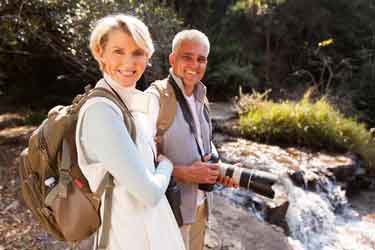
I cover important topics related to osteoporosis exercise including:
- Can exercise reverse osteoporosis?
- Stop the stoop — how to avoid kyphosis and rounded shoulders.
- Key components of an osteoporosis exercise program.
- Key principles of bone building.
- Exercises you should avoid if you have osteoporosis.
- Yoga and osteoporosis — should you practice yoga if you have osteoporosis?
- Core strength and osteoporosis — why is core strength important if you have osteoporosis?
Enter your email address and I will start you on this free course. I do not SPAM or share your email address (or any information) with third parties. You can unsubscribe from my mail list at any time.
Ball Exercise for Back and Spine: T, M and Y Positions (Athletic)
In this video, I demonstrate three Athletic level exercises for osteoporosis of the spine from the Exercise for Better Bones: Ball T, M and Y exercises.
Instructions
The following are the instructions for Ball Exercise for Athletic Level — the second of four exercises for osteoporosis of the spine.
Firm Surface for Support
Have a firm surface to press against for your feet when you first start doing this exercise. A wall works well, otherwise, you can use a bench with a stack of weights on it.
Another choice would be to press up against your sofa. Anything that is firm that you can press against works very nicely.
You want to, as much as possible, get your foot in contact with the floor and the wall, or the floor and the surface.
Use Running Shoes
A lot of my clients in their 50s and 60s have arthritis of their big toe and find this position very challenging for their feet. If that is the case, consider wearing running shoes while doing the exercise.
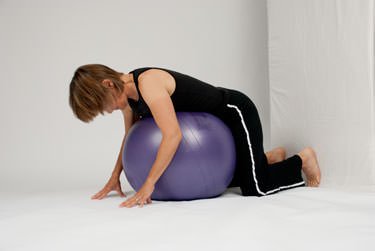
Step by Step Instructions
- Kneel tall behind the ball.
- Mount the ball.
- You have a choice of either lifting yourself onto the ball, or if you don’t have strong triceps, place one hand in front of you, take the other hand, and slip the ball underneath your pelvis.
- Ideally, in your start position, your knees will be just off the floor.
- This is the start position.
- Your back is flat, your feet are hip-width apart, so that you still feel balanced and stable as you press forward.
- When you’re first starting, you might want to focus on getting the extension of the knees.
- Straighten the knees and your torso, and come back down.
- Again, the direction of your trunk is as though you’re being lengthened towards the opposite wall and ceiling where they meet across the room.

Do Not Hyper Extend
The objective is not to hyper-extend your back and go way up to the ceiling. Again, it’s more of a lengthening.
Your head, as with most things, is always in a position where if I walked into your living room and flipped you up on your feet, your eyes would just be straight ahead. Always be in nice alignment because that’s where you want to be strong — in your best postural alignment.
Letter M
Let’s go through the M.
- Get onto the ball, breath in, and exhale coming into an M position.
- Use your arms to create an M form. Turn arms outward. Do not have your arms in because that’s going to close you up in through the chest. You’re looking for an outward position.
- Arms back down.
- With that, remember to squeeze the shoulder blades.
- Count one, two.
Start with a 2 second hold and over time try to hold the pose for a longer period. Your spinal extensions are back endurance muscles and can manage a 4-, 5-, 10-second hold.
Letter T
Put your arms out in front in order to get into the T pose. Keep them straight out so that when you look sideways, you don’t lock your elbows.
- Focus on your back muscles, so the shoulder blades are pulled together.
- Breath in, exhale coming out into the letter T.
- Your hands will end up at the height of your ears, so if you look to the side, you’ll see your hands to the height of your ears.
- Focus on lifting, lifting, lifting, lifting the whole time, and back.
- Back down.
Letter Y
With the letter Y, you don’t want to just hold your arms in place. You want to imagine that you have magnets in your ceiling that draw your arms up towards the ceiling the entire time.
Follow the same steps above in the letter T.
- Drive your arms, up, up, up, up, up towards the ceiling, and back down.
- One more time on the Y, breath in, and up, up, up, up, up, up, up.
- The whole time as you’re driving and holding that nice lengthening position.
- Back down.
Weight Bearing Exercise for Spine
A light weight on your back during either the ball M, T, U, V or Y can greatly increase the load on your spine. A one pound weight at the end of a long lever (in this case, your arms) can feel significantly heavier on the back muscles.
Ball T, M and Y • Tip for Professionals
Ball Exercise for Back and Spine: T, M and Y Positions (Elite)
The Ball T is a strength exercises for osteoporosis of the spine from the Exercise for Better Bones program. It is specifically designed for the Elite Level.
The exercise targets the muscles of the neck extensor, back, shoulders, and buttocks. It also targets the bones in the spine.
Instructions
The following are the instructions for Ball Exercise for Elite Level — the third of four exercises for osteoporosis of the spine.
At the elite level you don’t use any feet support.
You need more core stability and strength through not only plantar flexors, but your whole core extensors because you’re getting that extension without the help from the wall.
Use Running Shoes If Necessary
A lot of people get arthritis in the great toe in their 50s and 60s. Performing a push off with bare feet might be quite uncomfortable for them. If that is the case for you, I suggest you use running shoes.
If you have a wood or a linoleum surface, you want to make sure you are off of a yoga mat because you want to have enough grip from your toes.
- Start by kneeling straight behind the ball.
- Mount the ball and lift yourself onto the ball.
- Ensure that your toes are placed so that you get that nice push off.
- Have even weight bearing, if possible, through all your toes.
- You don’t want to be more on your big toe only or your little toes, so that your rotation in your lower body is in its neutral position.
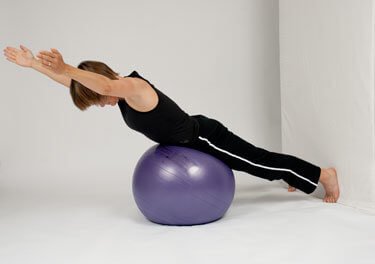
Letter M
We’re going start with the letter M.
- You’re flat over the ball and arms are in front of you.
- Take your breath in, and push forward into an M.
- Lift up.
- Now, as you come into your M, ensure that you are externally rotated.
- Open up through the shoulders and squeeze the shoulder blades together.
- Focus is not on hyperextending, but rather getting that healthy extension with elongation — as though you are being drawn across the room.
- And then back down.
Letter T and Y
We do the same thing with the T, except you come up into a 90-degree position in the arms. Hands are at the height of your ears.
- Again, lengthen.
- Keep a nice neutral neck. Do not come up or squeeze down.
- Nice neutral neck position.
- And back down.
- And one more with the Y.
- With the Y, you bring your arms into a Y position and drive them up.
As with the Ms and the Ts, the exercise doesn’t end when you lift up your arms. You want to drive your arms up, up, up, as though you had magnets in the ceiling that draw your arms up past your ears. Do this and you will feel the good work in the lower traps as well as all of your back muscles that are involved in the exercise.
I encourage you to do a longer hold. Your postural muscles are endurance muscles, and benefit from longer holds.
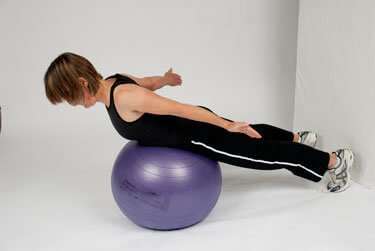
Exercise Recommendations for Osteoporosis
Exercise is an essential ingredient to bone health. If you have osteoporosis, therapeutic exercise needs to be part of your osteoporosis treatment program.
But what exercises should you do and which ones should you avoid? What exercises build bone and which ones reduce your chance of a fracture? Is Yoga good for your bones? Who should you trust when it comes to exercises for osteoporosis?
A great resource on exercise and osteoporosis is my free, seven day email course called Exercise Recommendations for Osteoporosis. After you provide your email address, you will receive seven consecutive online educational videos on bone health — one lesson each day. You can look at the videos at anytime and as often as you like.

I cover important topics related to osteoporosis exercise including:
- Can exercise reverse osteoporosis?
- Stop the stoop — how to avoid kyphosis and rounded shoulders.
- Key components of an osteoporosis exercise program.
- Key principles of bone building.
- Exercises you should avoid if you have osteoporosis.
- Yoga and osteoporosis — should you practice yoga if you have osteoporosis?
- Core strength and osteoporosis — why is core strength important if you have osteoporosis?
Enter your email address and I will start you on this free course. I do not SPAM or share your email address (or any information) with third parties. You can unsubscribe from my mail list at any time.
Additional Osteoporosis Exercises for Spine
Here is an additional exercises for osteoporosis of the spine, the spinal stretch.
Osteoporosis Exercise Plan
Visit my Osteoporosis Exercise Plan page for more information on this topic.

Comments